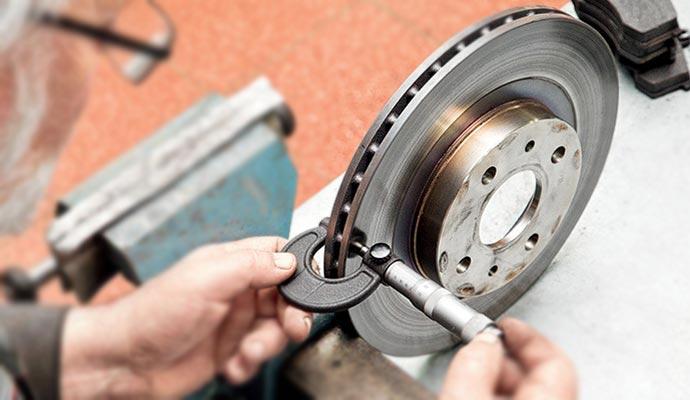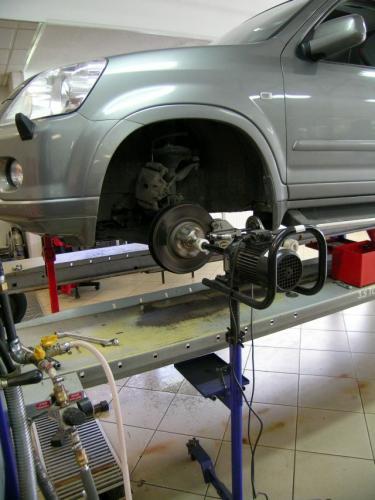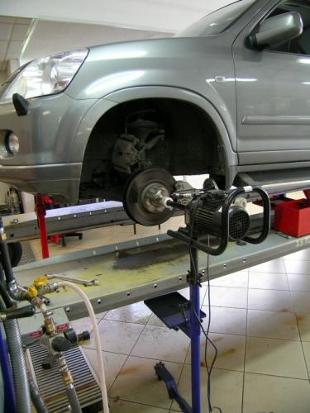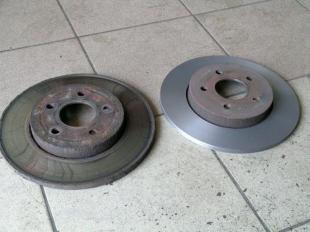
Replace discs or roll them up?
 When replacing brake pads, there may be a problem with the brake discs. Leave as is, replace with new ones or collapse?
When replacing brake pads, there may be a problem with the brake discs. Leave as is, replace with new ones or collapse?
When replacing brake pads, there may be a problem with the brake discs. Leave it as it is, replace it with new ones, or maybe roll it up? Unfortunately, there is no single answer to this question.
As usual in such cases, the procedure should depend on the state of the given element.
The decision to replace brake pads is very simple, and even an inexperienced driver can tell the difference between a good brake pad and a worn one. However, this is already with brake discs  a little bit worse.
a little bit worse.
The thickness of the discs varies greatly and varies (for cars) from 10 mm to 28 mm, so it can be difficult to correctly assess the condition of the discs. Thicker discs do not offer greater wear resistance, because regardless of the thickness, the wear that allows their further use cannot exceed 1 mm on each side. For example, if a new disc is 19mm thick, the minimum disc thickness is 17mm. Using a blade below the permitted thickness is not allowed and is very dangerous.
A worn disk heats up faster (even up to 500 degrees C) and is not able to dissipate a large amount of heat. As a result, the brakes overheat much faster, which means that braking efficiency is lost. Often this happens at the most inopportune moment (for example, when descending). A thin shield is also more likely to break.
When the disc thickness is above the minimum, it can continue to be used. Then, when replacing blocks, it is recommended to roll its surface in order to remove the bumps formed during cooperation with the old blocks.
Installing new pads on an old, unevenly worn disc can cause the brakes to heat up significantly during the first phase of use. This is due to the constant friction of the pads on the disc.
It is also recommended to flip the discs if the disc is rusty. Please note that after turning, the thickness must be greater than the minimum, and the surface must be pitted. Thickness  The material that we can collect is small, so such an operation is rarely possible in practice.
The material that we can collect is small, so such an operation is rarely possible in practice.
Disks with a run of 50 km, for example, have irregularities and wear is so great that after rolling it we will not get the minimum size.
A common damage to discs is their curvature (twisting). It manifests itself in unpleasant vibrations on the steering wheel after lightly pressing the brake already at a speed of about 70 - 120 km / h. Such a defect can occur even with new discs, with a sharp change in temperature (for example, hitting a puddle with very hot discs) or during intensive (for example, sports) use. Further driving with such damaged discs is very burdensome, because in addition to a significant deterioration in driving comfort, as a result of high vibrations, the entire suspension wears out faster.
However, such shields can be effectively repaired. It is enough to roll them up, preferably without disassembling them. This service is slightly more expensive (PLN 100-150 for two wheels) than classic turning on a lathe, but gives us 100% confidence that we will eliminate runout. In addition, in some vehicles, disk disassembly is costly and time consuming, as it requires the removal of the entire suspension.
Fortunately, in most vehicles, changing brake discs is very easy and takes little more time than just changing pads. The cost of replacing discs with pads ranges from PLN 80 to PLN 150. Shield prices vary greatly. Non-ventilated discs for popular models cost from PLN 30 to 50 apiece, and ventilated discs with a large diameter cost PLN 500 at all.
Before you decide to turn discs, you should find out how much new discs cost. It may turn out that you can buy a new kit for the same price or not much more. And the new shield is definitely better than the arrow-shaped one.
Examples of prices for brake discs
Make and model | Price of ASO (PLN / st.) | Replacement cost (PLN / piece) |
Fiat Punto II 1.2 | 96 | 80 |
Honda Civic 1.4 '96 | 400 | 95 |
Opel Vectra B 1.8 | 201 | 120 |